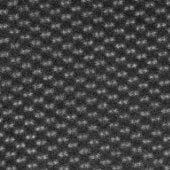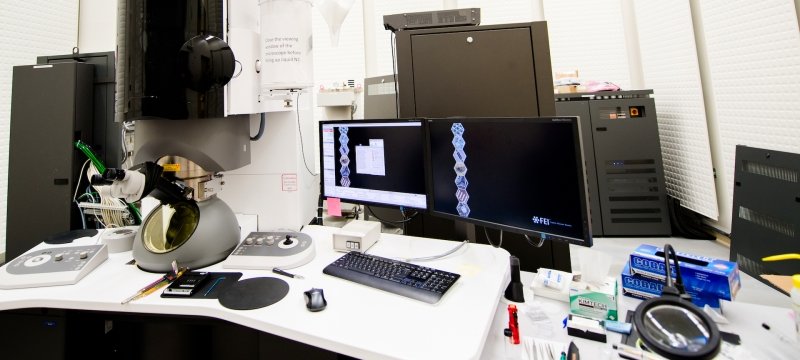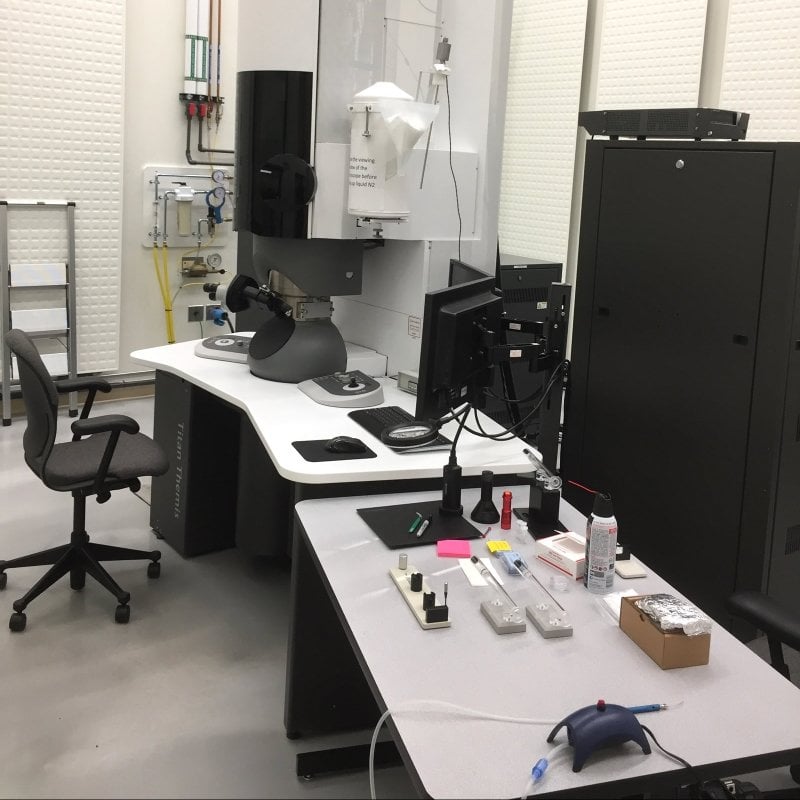The FEI 200kV Titan Themis Scanning Transmission Electron Microscope (STEM) is a scanning transmission electron microscope with several key capabilities.
This microscope positions Michigan Tech faculty on the leading edge of new imaging capability for structural and chemical analysis at the nanoscale. The microscope is housed in a building specially constructed for such an instrument capable of atomic resolution. This instrument represents one of only two Titans found in higher education in the state of Michigan. The Themis has a full complement of state-of-the-art accessories, including specialized specimen holders that extend the STEM utility.
TEM Grids
Pure Metal Grids
- Cu-grids, 300 mesh and 400 mesh (square mesh) (at M&M 631)
- Cu-Omniprobe Cu Lift-out-grids (3 posts) (at the FIB lab)
- Cu-Folding grids hexagonal mesh (at M&M 631)
TEM Grids with Support Film
All Carbon Type-A at M&M 631.
- Cu-grids with a continuous C-film (Cu-CF)
- Cu-grids with a Formvar stabilized lacey C-film (Cu-FLC)
- Cu-grids with a ultra-thin coated lacey C-film (Cu-UTLC)
- Cu-grids with a lacey C-film (Cu-LC)
- Ni-grids with a lacey C-film (Ni-LC)
- Ni-grids with a ultra-thin coated lacey C-film (Ni-UTLC)
Special Grids
Contact Erico Freitas to obtain grids.
- Au-grids with a ultra-thin coated lacey C-film
- Cu-grids with a silicon monoxide film
- Cu-single slot coated with a Formvar film
- Silicon frames with a square well coated with SiN film
- Cu-grids with single layer graphene coated lacey C-film
See the PELCO® TEM Grid Support Film Application Guide from Ted Pella, Inc., for a useful chart to help you find out what type of TEM grid works best for your TEM work. Most of the listed types of substrates in that table are available for the ACMAL STEM users.
Grid Instructions
- Slide off the lid of the desiccator to open it. It is fragile, so be careful.
- Use the provided pair of tweezers (inside the desiccator) to pick up the grids you need. Handle tweezers with care. Their tip can easily bend and get damaged.
- Always manipulate the grids over a clean surface (piece of Al foil or kimwipe).
- Take the type and number of TEM grids you need.
- Fill in the log book.
- Date
- User name
- Grid box ID
- # grids taken
- Grid positions
- Observations
- Write down your name in the original grid position in the grid box map. (See in the piece of paper inside the bag—follow the legend when filling in the provided grid box map.)
- Place the tweezers back in the desiccator.

Under the Titan Lens: Microscope Takes Research to Atomic-Level
Remote Training and Collaboration
- Zoom screen-share from both the TEM laboratory web camera and instrument control monitors
- Huskycast (Panopto) recording of lab space, TEM lab camera, and instrument control monitors
Ex situ and In situ Capabilities
Conventional TEM (CTEM)
Accelerating Voltages from 80–200 kV
- High Contrast images (desired for standard biological TEM samples) at Low Magnification mode (field of view from 100 microns to 1 micron)
- High Resolution TEM (HRTEM) to identify lattice spacings less than 0.15 nm
- Crystallographic phase analysis in Diffraction mode:
- Selected Area Electron Diffraction (SAD) from a minimum area of 200 nm in diameter
- Convergent-beam Electron Diffraction (CBED) analysis: e.g. determination of crystal system, Bravais lattice, point, and space groups of crystals larger than 50 nm in size
- Nanobeam Electron Diffraction (NBD) analysis (Convergent semi-angle less than 0.1 mrad)

Probe Corrected Scanning Transmission Electron Microscopy (STEM)
Accelerating Voltages from 80–200 kV
- Z-contrast images by High-angle Annular Dark-Field (HAADF) (Fischione HAADF detector)
- Atomic resolution Z-contrast imaging by HAADF-STEM
- Annular Dark-Field (ADF), low angle ADF, and Bright-Field STEM imaging (useful for grain size, dislocations and defect imaging)
- Micro-probe STEM with larger depth of focus
ChemiSTEM Super X-ray Energy Dispersive Spectroscopy
Four X-ray Detectors, FEI/ThermoFisher
- Fast elemental analysis and elemental mapping up to very high spatial resolution (combined with HAADF-STEM)
- Clear and low background XEDS spectrum using the beryllium specimen holder.
- 3-dimension elemental analysis reconstruction (STEM EDS Tomography)
Electron Energy Loss Spectroscopy (EELS)
GIF Quantum Dual EELS System
- Elemental analysis from Li–U at very high spatial resolution (combined with HAADF-STEM)
- Elemental mapping and phase mapping by STEM-EELS spectrum imaging
- Low-loss and core-loss EELS with energy resolution of 0.9 eV
- Oxidation state analysis by core-loss EELS
- Thickness measurement
Energy Filtered TEM (EFTEM)
GIF Quantum Dual EELS System
- Elastic electron imaging to enhanced contrast of TEM images and diffraction patterns
- Thickness and elemental mapping (in EFTEM mode) and EFTEM spectrum imaging
Ex situ TEM Sample Holders
- Single Tilt holder (FEI/ThermoFisher)
- Beryllium tip Double Tilt holder (FEI/ThermoFisher)
- Room temperature tomography holder (Fischione) for both TEM and STEM tomography

TEM Sample Holder Loading for Talos TFS (FEI) F200X
This is an introduction to load a TEM grid to the single-tilt holder and load the holder to the microscope.
In situ TEM Sample Holders
- Electrical bias and Heating stage NanoEx holder (FEI/ThermoFisher)
- Nanoindentation holder (Nanofactory)
- Poseidon 510 liquid cell holder (Protochip)
The video is created from 130 images (commonly known as slices) of a conglomerate of Li-ion battery cathode particles.

STEM Tomography of Li-ion Battery Cathode Particles
Training
Courses
Michigan Tech offers many undergraduate and graduate courses related to materials characterization.
One of these courses offers direct, hands-on training in transmission electron microscopy.
MSE 5550 Course Topics
- Lenses and Apertures (ray diagram)
- Introduction to the TEM
- Lenses and Apertures (condenser system)
- TEM basic alignments and condenser aperture system
- Lenses and Apertures (imaging/diffraction mode)
- Lenses and Apertures (three major defects)
- Parallel illumination and Objective Aperture
- Lenses and Apertures (depth of focus/field)
- Scattering (scattering cross section)
- Electron diffraction, image formation and contrast
- Scattering (Fresnel fringes)
- Scattering (image formation and contrast)
- S-TEM
- Elastic Scattering vs. Inelastic Scattering
- Selected area electron diffraction (“powder” diffraction)
- X-ray Spectroscopy, XEDS
- Diffraction
- STEM imaging and XEDS
- XEDS, EELS
- EELS
- STEM imaging and EELS
- Phase Contrast Images
- Phase contrast imaging
- High Resolution TEM (transfer function)
- High Resolution TEM (Scherzer defocus)
- HRTEM imaging
- Crystallography and Diffraction (Bragg’s law)
- Crystallography and Diffraction (reciprocal lattice)
- Zone Axis electron diffraction (SAD)
- Crystallography and Diffraction (diffraction patterns)
- Crystallography and Diffraction (indexing DPs)
- Diffraction from Small Volumes
- Dynamical Diffraction (effective excitation error)
- Convergent beam electron diffraction (CBED)
- Dynamical Diffraction (thickness/bending effect)
- Convergent Beam Electron Diffraction
- Liquid phase TEM imaging

